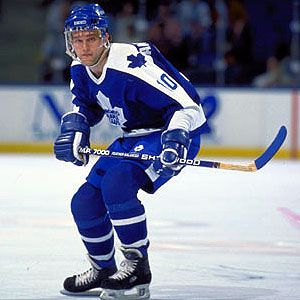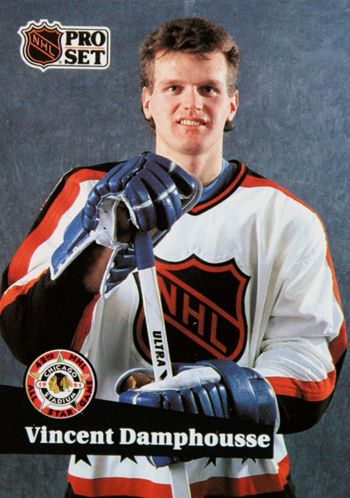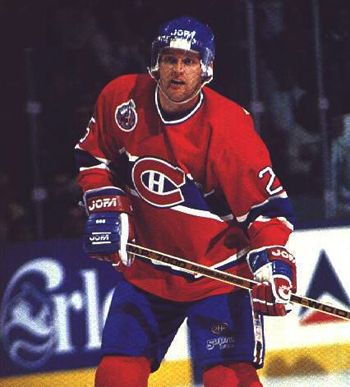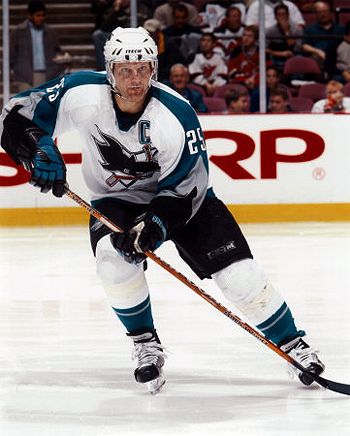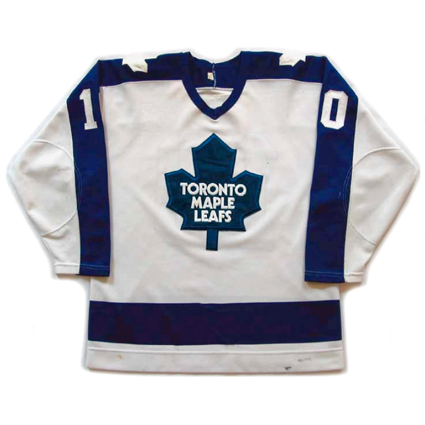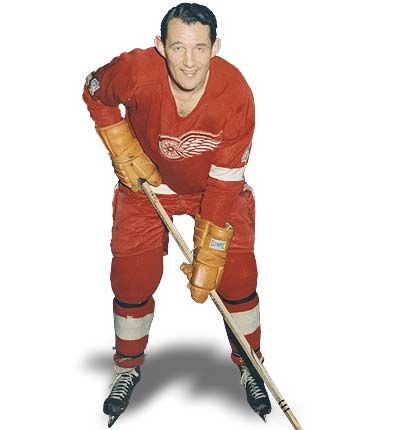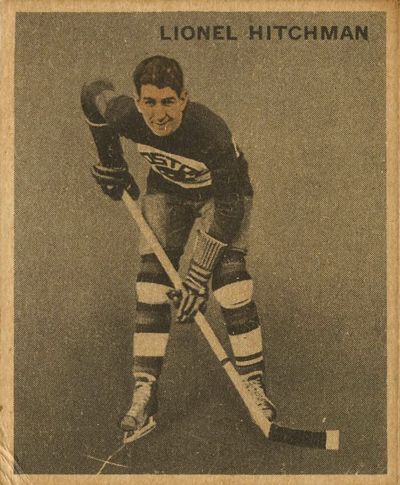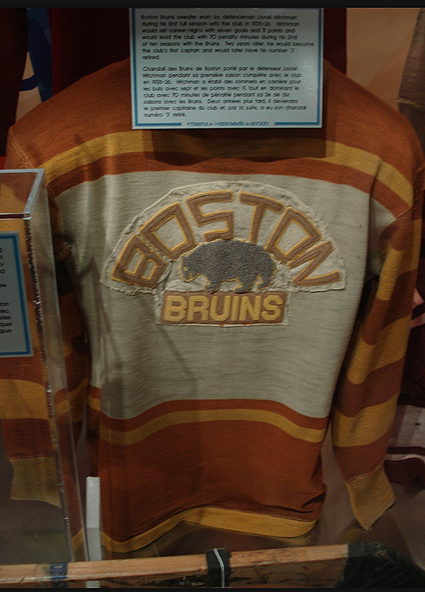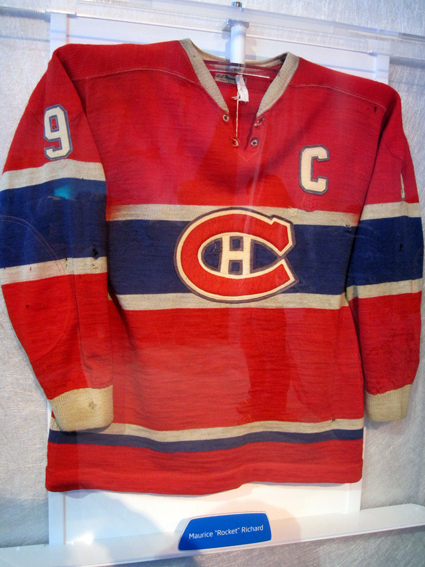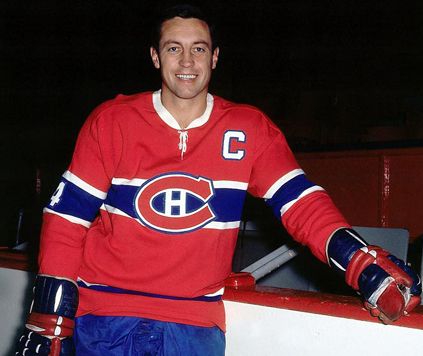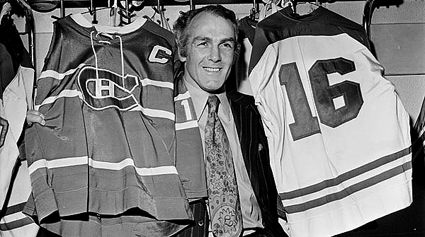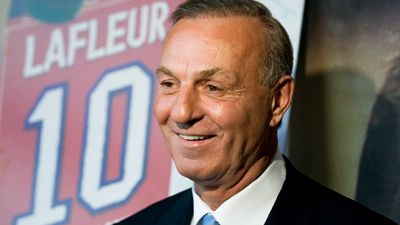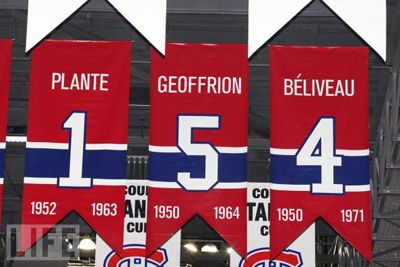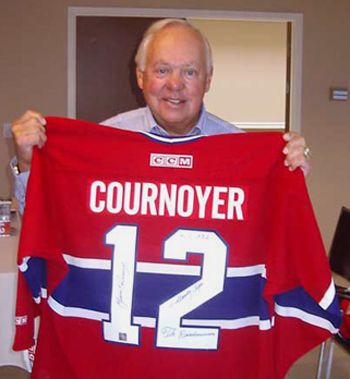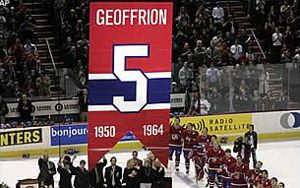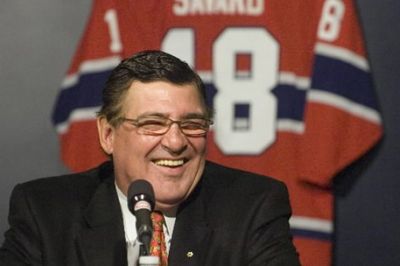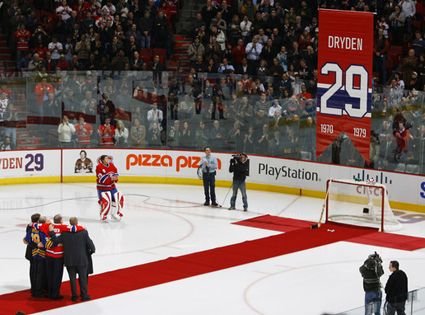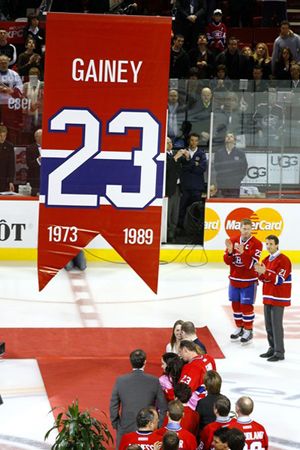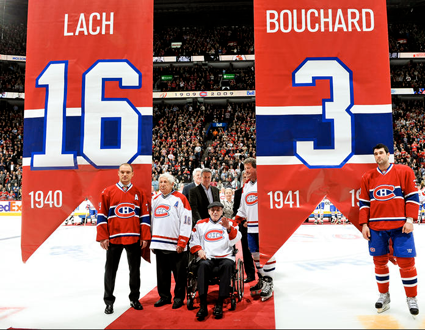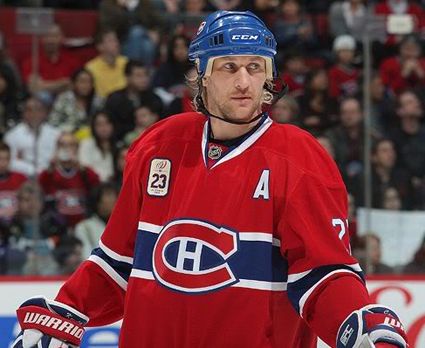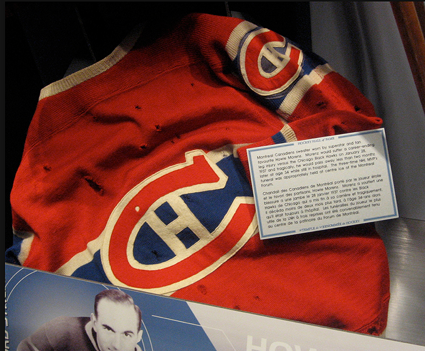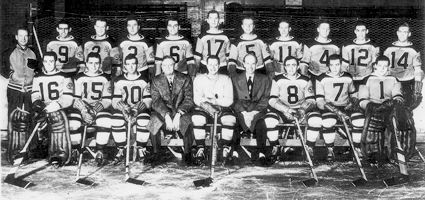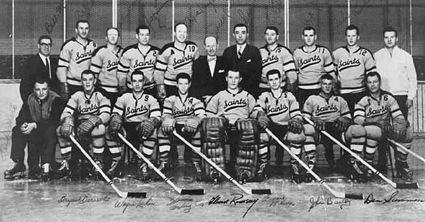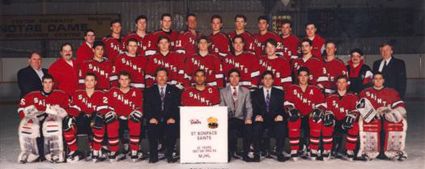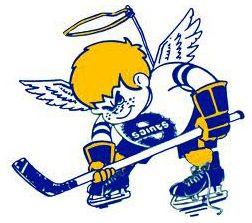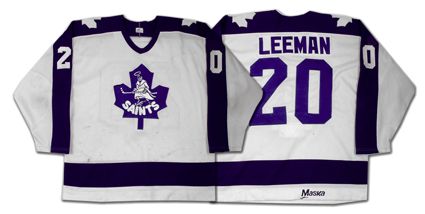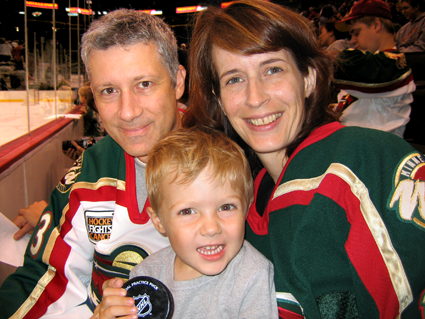Saturday, November 6, 2010
1986-87 Toronto Maple Leafs Vincent Damphousse Jersey
Vincent Damphousse played his junior hockey first with the Laval Voisins of the Quebec Major Junior Hockey League in the 1983-84 season and made his junior debut a noteworthy one, coming up just a point shy of averaging a point per game, finishing with 29 goals and 36 assists for 65 points in 66 games. Laval won the league playoff championship that season and Damphousse contributed five goals and eight points in 12 games.
His second season with the Voisins was a large step forward for Damphousse. While he raised his goal totals from 29 to 35, he nearly doubled his assists from 36 to 68. As a result, his overall points went from 65 to 103.
The Laval club would change its name from the Voisins to the Titan for the 1985-86 season and Damphousse would again take another quantum leap in his game. 45 goals and 110 assists gave Damphousse fifth place in the league scoring race with 155 points in 69 games.
That performance would leave Damphousse squarely in the sights of the scouts and the Montreal native was drafted 6th overall in the 1986 NHL Entry Draft by the Toronto Maple Leafs.
His NHL career began on October 9, 1986 against his hometown Canadiens with a 7-4 win. The Maple Leafs got off to a strong start that season and went into their 13th game with a 7-2-3 record. They travelled to Minnesota and Damphousse would score his first NHL goal on this date in 1986 as the Maple Leafs fell to the Minnesota North Stars by a score of 4-1.
Damphousse would play in all 80 games that season and finish with 21 goals and 46 points. The following season he would miss five games, yet score two more points overall.
Over the course of the next three seasons he would play in 239 of a possible 240 games. 1988-89 saw his point total raise to 68 and in 1989-90 Damphousse set personal highs in goals, assists and points with his first 30 goal season, totaling 33. His 61 assists pushed his point total to 94, one shy of the team lead.
His successful season contributed to his being selected to play in the NHL All-Star Game the following season in which he was named the MVP of the game after tying a record by scoring four goals.
The Maple Leafs would take a big drop in the standings the next season, which affected everyone's point totals, and although Damphousse's total dropped from 94 to 73, it was enough for him to lead the team in scoring for the first time.
Looking to revamp their lineup after finishing 20th out of 21 clubs, the Maple Leafs sent Damphousse, goaltender Peter Ing, Scott Thornton, Luke Richardson and cash (something the Maple Leafs were not known to part with under previous owner Harold Ballard's rule!) to the Edmonton Oilers for Grant Fuhr, Glenn Anderson and Craig Berube, ending Damphousse's days in Toronto.
Damphousse's stay in Edmonton would be short, as he was traded to the Montreal Canadiens after just one season. The trade to his hometown Canadiens would energize Damphousse, who set a career high with 97 points to lead the team in scoring. Once in the playoffs, he would continue to lead the club in scoring with 11 goals and 12 assists for 23 points in 20 games to lead Montreal over the Los Angeles Kings 4 games to 1 to capture the Stanley Cup.
During his seven seasons in Montreal, he would record two more seasons with over 90 points, lead the club in scoring three times and be named team captain in 1996. He would also make his only international appearance in 1996 when he was a member of Team Canada for the 1996 World Cup of Hockey.
In March of 1999, Damphousse was dealt to the San Jose Sharks where he would play the final six seasons of his career. He would play every game of his final three seasons and also serve as team captain for part of his final season. 2002 would see him play in his third NHL All-Star Game, after an appearance in 1992.
He had signed with the Colorado Avalanche for 2004-05, but the NHL lockout prevented him from playing for the Avalanche and brought an end to his playing days. His career would conclude with 432 goals and 1205 points in 18 NHL seasons.
Just announced four days ago was the news that Damphousse would be inducted into the QMJHL Hall of Fame on April 6, 2011 in Montreal.
Today's featured jersey is a 1986-87 Toronto Maple Leafs Vincent Damphousse jersey, as worn during his rookie season in the NHL. This jersey was actually used by winger John Anderson starting in 1983 before being recycled to Damphousse in 1986.
The Maple Leafs adopted this style back in 1970 when they introduced the new modern version of their team logo.
Against the wishes of the club, the team capitulated and added names to the back in 1978 and maintained the use of this style through the 1991-92 season. The success of their Turn Back the Clock jersey that season led to a redesign for the following year which incorporated the retro style leaf as a secondary logo and a return to a classic striping pattern for the jersey.
In today's video section, Damphousse scores in overtime to defeat la Rangers.
Here, Damphousse scores the first goal in the Canadiens new home, the Molson Centre at 6:13 of the first period when the Canadiens defeated the Rangers 4-2. And there was much rejoicing.
In this next video, Damphousse completes a dramatic comeback by the Sharks over the Kings.
Finally, Vincent is looking fine and seems quite fond of touching his own hair.
Labels:
Damphousse Vincent,
Toronto Maple Leafs
Friday, November 5, 2010
2005-06 Toronto Maple Leafs Mats Sundin Jersey
Today kicks off the 2010 Hockey Hall of Fame Induction Celebration, which will honor Dino Ciccarelli, Jim Devellano, Cammi Granato, Angela James and the late D. K. "Doc" Seaman.
The events take place over the course of four days, beginning today with the opening of the new "Spirit of Hockey" retail store, which is being relocated from it's lower concourse location to street level next to the Hall's historic bank building where the Stanley Cup is housed.
Additionally, the World of Hockey Zone has now expanded by taking over the old store's vacant space to grow to approximately 6,000 square feet, making it the Hall's largest dedicated exhibit area. New exhibits will feature the IIHF Hall of Fame and International Legends, Triple Gold Club and Top 100 Moments in international hockey.
Also on Friday, Hall of Famers Johnny Bower, Billy Smith and Peter Stastny will be signing copies of the Hockey Hall of Fame's two newest books, Hockey Hall of Fame Book of Goalies: Profiles, Memorabilia, Essays and Stats and Official Guide to the Players of the Hockey Hall of Fame
and Official Guide to the Players of the Hockey Hall of Fame .
.
Saturday kicks off with "keeper of the cup" Phil Pritchard presenting behind-the-scenes stories and photos of the Stanley Cup's journeys at 11 AM and 2 PM. Following the 11 AM presentation, Pritchard and Maple Leaf legend Ron Ellis will sign copies of Travels with Stanley . After the 2 PM presentation, Pritchard and Hall of Famer Scotty Bowman will sign Travels with Stanley.
. After the 2 PM presentation, Pritchard and Hall of Famer Scotty Bowman will sign Travels with Stanley.
The Women's Hockey Fan Forum will feature a question and answer session at 3:30 PM with Olympic gold medalists Lori Dupuis and Vicky Sunohara of Canada and Chris Bailey of the United States.
At 7 PM that evening the host Toronto Maple Leafs take on the Buffalo Sabres at the Air Canada Centre in the annual Hockey Hall of Fame Game, where both teams will wear a special commemorative patch to mark the occasion.
Sunday, November 7th sees a limited edition print giveaway for every guest of the Hall of Fame, with the first 500 being autographed by the 2010 inductees.
Those same inductees will be on hand to participate in the 2010 Inductee Fan Forum at 11:30 AM for an hour long question and answer session.
The festivities then move back to the Air Canada Centre for the Hockey Hall of Fame Legends Classic in which the "Canada Legends" take on the "USA Legends" game, which will feature Glenn Anderson, Dino Ciccarelli, Paul Coffey, Michel Goulet, Angela James, Lanny McDonald, Steve Shutt, Darryl Sittler, Bill Smith, Peter Stastny, Brian Bellows, Wendel Clark, Lori Dupuis, Ray Ferraro, Gary Leeman, Claude Lemeiux and Rick Vaive for Canada taking on Cammi Granato, Rod Langway, Bryan Trottier, Chris Bailey, Bobby Carpenter, Dave Ellett, Tom Fergus, Tony Granato, Phil Housley, Al Iafrate, Pat Jablonski, Grant Ledyard, Shelley Looney, Sue Merz, Chris Nilan and Joel Otto for the USA.
Then on Monday the Hall of Fame will close for the induction ceremony, with the Gala Celebration beginning at 5:50 and the Induction Ceremony itself at 7:30, which will be broadcast live on TSN2 and the NHL Network in both the US and Canada.
Today's featured jersey is a 2005-06 Toronto Maple Leafs Mats Sundin jersey. This jersey features the Hockey Hall of Fame Game patch as worn on the jerseys of the participating teams each year during the annual Hockey Hall of Fame Game, which began back in 1999.
Aside from the host Maple Leafs, other teams to have worn the patch, which is unique each year as it carries the date of the game, include the New York Rangers (1999), the Chicago BlackHawks (2000), the New Jersey Devils (2001), the Montreal Canadiens (2002), the Philadelphia Flyers (2003), the Tampa Bay Lightning (2005), the Montreal Canadiens (2006), the New York Rangers (2007), the Montreal Canadiens (2008) chosen again as part of their centennial celebration, and the Detroit Red Wings (2009).
Today's video segment begins with a look at the Hockey Hall of Fame.
Here are last year's inductees being introduced prior to the Hall of Fame Game last season.
Labels:
Sundin,
Toronto Maple Leafs
Thursday, November 4, 2010
1953 NHL All-Star Bill Gadsby Jersey
Bill Gadsby broke into the NHL in 1946 with the Chicago Black Hawks as an 18 year old defenseman in 1946 after just 12 games in the minors. He was welcomed to the NHL with a cut that required 12 stitches in his first game, but went on to score 8 goals and 18 point that first season. He was a regular on Chicago's blueline for the next eight seasons, including being named team Captain in 1952, the first season the Black Hawks qualified for the playoffs during Gadsby's time in Chicago.
Early in the 1954 season, Gadsby was dealt to the New York Rangers as part of a five player deal. Gadsby would rarely miss a game while with the Rangers, never playing less than 65 games (of a 70 game schedule) in six seasons in New York. Playing with the Rangers was good for Gadsby's style of play, as his point totals increased from a high of 41 in Chicago (his only season there over 35) to having five of six seasons in New York with 35 or more, including a career high of 51 twice, first in 1955-56, which placed him ninth in league scoring, and 1958-59, which included a league record 46 assists for a defenseman. He also set a career high of 14 goals in 1957-58 while with the Rangers. Playoff success continued to elude Gadsby however, as the Rangers only made the playoff three times in seven chances, a trio of first round exits.
In 1960 Gadsby was traded to the Detroit Red Wings and continued his dependable play, including two of his seven seasons in which he played every game of the season. Early in his second season in Detroit, Gadsby became the first defenseman in NHL history to reach 500 career points, which he did on this date in 1962 in a 3-1 Red Wings win over Chicago.
Later that year, in his 17th season in the NHL, Gadsby would finally reach the Stanley Cup Finals for the first time. Detroit would return to the finals again the following season, only to fall to the Toronto Maple Leafs both times. Two seasons later Gadsby would play his final NHL season, capped off by his third trip to the finals.
His career would conclude with 130 goals and 438 assists for 568 points which still ranks 40th all time among defensive scoring despite the massive changes in the game after the arrival of Bobby Orr. In addition to his impressive point totals for his day, he also received as many as 600 stitches to his face, but didn't mind too much, as he had an insurance policy which paid him $5 for every stitch!
Gadsby was inducted into the Hockey Hall of Fame in 1970.
Today's featured jersey is a 1953 NHL All-Star Bill Gadsby jersey. This style of jersey was used from 1947 to 1954 and was worn by Gadsby in the first two of his eight All-Star Game appearances in 1953 and 1954.
Labels:
Gadsby Bill,
NHL All-Star Game
Wednesday, November 3, 2010
1928-29 Boston Bruins Lionel Hitchman Jersey
Lionel Hitchman played 12 seasons in the NHL for both the Ottawa Senators and the Boston Bruins.
He was born on this date in 1901 and signed with the Senators after playing two seasons of senior hockey for the Ottawa New Edinburghs.
After playing in just three regular season games and five playoff games, Hitchman found himself competing for the Stanley Cup in just his ninth game as a professional. In that game, Hitchman scored the tying goal in the third period before the Senators won in overtime. During the second game, which Ottawa won by a score of 1-0 to capture the Stanley Cup, Hitchman played with a broken nose.
Hitchman, a defenseman, played another season and a half for the Senators prior to being sold to the Boston Bruins midway through their inaugural season of 1924-25.
Over the next eight seasons with the Bruins, Hitchman was a steady and reliable performer who rarely missed a game. By 1927 Hitchman was named the first captain of the Boston Bruins, as they played their first three seasons without one.
The first Bruins captain - Lionel Hitchman
Paired on defense with the legendary Eddie Shore, the pair were a force in the early NHL after Shore's arrival in 1926, a season in which the Bruins made it to the Stanley Cup Finals for the first time.
They would return to the finals again in 1929, this time defeating the New York Rangers 2-0 in Boston and 2-1 in New York to win the first championship in club history.
The Bruins would return to the finals again the following season, but come up short against the Montreal Canadiens.
Midway through the 1933-34 season, Hitchman would leave the Bruins and play for the Boston Cubs of the Canadian-American Hockey League for the latter half of the season to close out his playing days prior to becoming the head coach of the Cubs.
His final NHL totals were 27 goals and 33 assists for 60 points and a then NHL career record 523 penalty minutes in 414 games.
Hitchman holds the distinction of being the first player in NHL history to have his number retired when the Bruins honored his #3 at the conclusion of his playing days on February 22, 1934.
Today's featured jersey is a 1928-29 Boston Bruins Lionel Hitchman jersey. The Bruins wore a different style in each of their first two seasons before adopting this style in 1926. They would continue to wear this sweater for six seasons, including a Stanley Cup championship in 1929.
Our video selection today is a look at the history of the Boston Bruins, including some great old footage and photos.
Labels:
Boston Bruins,
Hitchman Lionel
Tuesday, November 2, 2010
1934-35 Montreal Canadiens Howie Morenz Jersey
On this date in 1937, the Montreal Canadiens retired the first sweater in club history, the #7 of the late Howie Morenz, who had died at age 34 following a heart attack while hospitalized for a broken leg suffered in a game five weeks earlier. Morenz had played for Montreal for 12 seasons, winning three Stanley Cups, two Art Ross Trophies and three Hart Trophies.
Howie Morenz's #7 jersey hangs in his locker in the Canadiens dressing room following his death in 1937
The Canadiens would not retire another number for 23 years when the iconic #9 of Maurice Richard was raised to the rafters of the Montreal Forum following Richard's great career, which included him becoming the first player to score 50 goals in 50 games, as well as winning eight Stanley Cups and one Hart Trophy.
Richard's game worn #9 jersey
Eleven years on, the Canadiens would honor the great Jean Beliveau by ensuring no one else would wear his #4. Beliveau would play 20 seasons with Montreal, score over 500 goals, retire as the club's all-time leading scorer and the NHL's leading playoff scorer, play in 14 All-Star Games, win an Art Ross Trophy, a Conn Smythe Trophy and a pair of Hart Trophies on his way to winning ten Stanley Cups and serve as team captain longer than any other player.
Beliveau wearing his #4 captain's jersey
Henri Richard's #16 was next to be set aside on December 10, 1975 after his career which included his record 11 Stanley Cups, which still stands today, and more than 1,000 career points. He also holds the record for Most Games Played in club history and was also a team captain for the Canadiens.
Henri Richard poses with his home and away #16 sweaters
Both Guy Lafleur and defenseman Doug Harvey had their numbers retired in 1985. Lafleur's #10 received the honor on February 16, 1985 after his career, which included five Stanley Cups, 1,246 points which makes him the all-time leader in Canadiens history, over 500 goals, the club records for most goals in a season with 60 and most points in a season with 136. He was also the first player to have 50 goals and 100 points in six consecutive seasons and the fastest player to reach 1,000 career points. He won three Art Ross Trophies, two Hart Trophies, three Pearson Awards and a Conn Smythe trophy while a member of the Canadiens.
Lafleur pictured in front of his #10
#2 Doug Harvey was honored with his sweater retirement early the following season on October 26, 1985. The seven-time winner of the Norris Trophy played 14 seasons with Montreal, winning six Stanley Cups in the process.
It would be another ten years before Jacques Plante's #1 was raised to the rafters. Plante played for Montreal for ten seasons, winning six Stanley Cups, including five in a row. Plante was a winner of the Hart Trophy once and six Vezina Trophies while a member of the Canadiens. He is also credited for wearing the first modern goalie mask.
Plante's banner hangs in the rafters with the other retired banners
Following Plante's jersey retirement, it would be an additional ten years before the Canadiens would honor another player in the same manner.
As part of their Centennial celebrations, the Canadiens announced a series of sweater retirements to take place over the course of the next five seasons. Having retired just one number in 20 years, the Canadiens began to make up for lost time by retiring the #12 for two men, Dickie Moore and Yvan Cournoyer on November 12, 2005. Moore was a two-time Art Ross Trophy winner who once held the single season scoring record with 96 points. In 12 years with the Canadiens, Moore won six Stanley Cups.
Cournoyer skated for the Canadiens for 16 years, including being named team captain. He won a Conn Smythe Trophy and won ten Stanley Cups while with the Canadiens. At the time of his retirement in 1978, he was fourth on the all-time Montreal scoring list.
Cournoyer holds up a signed #12 Canadiens jersey
Bernie "Boom Boom" Geoffrion's #5 came next on March 11, 2006. Geoffrion's colorful nickname is a result of his invention of the slapshot. He played 14 seasons in Montreal, won the Calder Trophy, two Art Ross Trophies, the Hart Trophy and six Stanley Cups. Sadly, he passed away on the day his number was retired.
The ceremony to retire Geoffrion's #5 just hours after his passing
The 2006-07 season saw the retirements of #18 for Serge Savard and #29 for goaltender Ken Dryden. Savard became the first defenseman to win the Conn Smythe Trophy in 1969. He also was named the winner of the Bill Masterton Trophy in 1979 and won eight Stanley Cups in 15 seasons with Montreal.
Serge Savard's #18 rests in the rafters in Montreal
Dryden's career was shorter at eight seasons, but during those years he won the Calder Trophy, the Conn Smythe Trophy (before winning the Calder!), five Vezina Trophies and six Stanley Cups.
Ken Dryden and his family watch is banner being raised in 2007
Larry Robinson and Bob Gainey were honored in 2007-08. Robinson's #19 rose to the rafters in honor of his 17 seasons with Montreal which included two Norris Trophies, a Conn Smythe and six Stanley Cups. In 1976-77 he finished the year with a +120 rating, the second highest in history, and one of only two seasons ever over +100.
Robinson's #19 is retired
Bob Gainey's #23 was retired following his 16 seasons with Montreal which saw him capture four Selke Trophies. While his list of awards is not as lengthy and his point totals not as high as his fellow honored Canadiens, his role as a defensive forward was a key component to the five Stanley Cups Montreal won during Gainey's time with the Canadiens.
Gainey's #23 is raised to the rafters
Patrick Roy was welcomed back into the Canadiens family on November 22, 2008. Roy is the youngest winner of the Conn Smythe Trophy at age 20. In 12 seasons in Montreal, Roy won three Vezina Trophies, four Jennings Trophies, two Conn Smythe Trophies and two Stanley Cups.
Patrick Roy poses with his banner
Finally on the date of the Canadiens centennial, December 4, 2009, the jerseys of both #3 Emile Bouchard and #16 Elmer Lach were surprisingly retired as part of the festivities that evening. Lach played 14 seasons for the Canadiens as part of the famed "Punch Line" with Maurice Richard and Toe Blake. He won two Art Ross Trophies and the Hart Trophy as well as three Stanley Cups. At the time of his retirement in 1954, he was the league's all-time leading scorer.
Bouchard, a defenseman, was captain of the Canadiens for eight seasons during his 15 years with Montreal, which included four Stanley Cup titles. He was the first Quebec-born player to wear the "C" for Montreal. The QMJHL's Defenseman of the Year trophy is named in his honor. At the time of Bouchard's sweater retirement, Canadiens player Ryan O'Byrne was wearing #3, but surrendered it as part of the ceremony, permanently changing to #20.
Lach and Bouchard have their numbers retired in 2009
With the recent run of sweater retirements, the Canadiens have now taken 15 numbers out of circulation in honor of 17 players. Only numbers 6 and 8 remain in the single digits, resulting in an unprecedented number of Canadiens wearing non-traditional jersey numbers higher than #30.
In keeping with the current trend of wearing a patch on the occasion of a jersey retirement, the Canadiens have worn special patches on the players jerseys during the game following their recent jersey retirements.
Alexi Kovalev wearing a patch on the occasion of the retirement of Bob Gainey's #23
Today's featured jersey is a 1934-35 Montreal Canadiens Howie Morenz jersey. This jersey is on display at the Hockey Hall of Fame in Toronto. His was the first of 15 numbers retired by the Montreal Canadiens.
The Canadiens first wore their "CH" logo back in 1916 and it appeared on the sleeves for the first time in 1924 when the club wore a globe on the front of their jerseys to symbolize their status as world champions. The following season the logo returned to the chest, but the smaller version of the logo remained on the left sleeve through 1935.
In a wonderful ceremony on the occasion of the clubs 100th Anniversary, many of the men who have had their jerseys retired by the Canadiens took part in a special pre-game warmup and then participated in the remainder of the celebrations that evening, which included the unexpected retirement of Bouchard's #3 and Lach's #16.
Monday, November 1, 2010
1972-73 Minnesota Fighting Saints Terry Ball Jersey
October 31st, Halloween, is sometimes referred to as "All Hallows Eve", making November 1st "All Hallows", with "hallows" being defined as "to consecrate or set apart as being holy". Thus, All Hallows celebrates all those who have been set apart as being holy by being named to sainthood, which leads to another name for All Hallows - "All Saints' Day".
A search of HockeyDB.com reveals twenty teams named "Saints" at various levels of hockey as far back as 1925 with the original incarnation of the St. Paul Saints of the Central Hockey League. The Saints then moved to the American Hockey Association for four seasons, back to the CHL for four, which included winning the league championship in 1935, and once more back to the AHA for seven seasons until World War II brought a temporary halt to the league. When play resumed in 1945, the Saints were now part of the United States Hockey League until 1955 and took home the championship in 1949.
The 1948-49 USHL champion St. Paul Saints
In 1959 the St. Paul Saints name would be revived with a new franchise in the International Hockey League, which would continue play through 1963 until their name was changed to the St. Paul Rangers to reflect their affiliation with the NHL's New York Rangers. This edition of the Saints was quite successful, appearing in the Turner Cup Finals three consecutive seasons, winning championships in both 1960 and 1961 and having their reign ended in 1962.
The 1960 IHL Champion St. Paul Saints
Next on the scene was the St. Catharines Saints in 1940 in the Ontario Hockey Association in Canada. That club lasted only two seasons, but the name was revived in 1982 when a new club joined the American Hockey League in 1982. That club stayed for four seasons prior to a relocation to Newmarket, Ontario where they were now known as the Newmarket Saints until 1991. After another relocation resulted in a name change, followed by yet another in 2005 which currently has them known as the Toronto Marlies.
A little known club in Minnesota called the Hibbing Saints played for one season in the Northern Hockey League. The fourth Saints franchise was the Sherbrooke Saints of the Quebec Senior Hockey League from 1949 to 1954.
The St. Boniface Saints had a long run in the Manitoba Junior Hockey League from 1967 to 2001 before new owners renamed them the Winnipeg Saints where they continue to play in Canadian Tier II Junior "A" hockey.
The 1992-93 St. Boniface Saints
Also formed in 1967, the Windsor St. Clair Saints played in the Ontario Colleges Athletic Association and dominated with championships in 1968, 1969, 1970, 1973, 1975, 1976, 1977 and 1979. They also won the Canadian Colleges Athletic Association National Championship in 1976.
After an extended break from competition, the St. Clair Saints returned in 2001 and won the OCAA championship in 2002 and 2003. Following the demise of the OCAA, the Saints eventually joined Major League Hockey, playing against Senior AAA level teams from 2006 to 2008 before ceasing operations.
The St. Claire Saints pay a hospital visit in 2008
The Laval Saints of the Quebec Major Junior Hockey League lasted but one season in 1969-70.
The next club to arrive on the scene with the Saints name did so with a twist. As founding members of the World Hockey Association in 1972 based in St. Paul, Minnesota, the new club elected to call themselves the Minnesota Fighting Saints. They created one of the best logos hockey has ever seen, which has been copied again and again since then. The Fighting Saints also played a firey, uptempo brand of hockey with plenty of fisticuffs and occasional mayhem thrown in to live up to the team name.
Competing with the NHL's Minnesota North Stars, who were in a down period on the ice at the time, the always competitive Fighting Saints captured the hearts of the Minnesota hockey fans and played to several record setting capacity crowds of over 17,000 at their brand new St. Paul Civic Center on the current site of the Minnesota Wild's Xcel Energy Center.
The 1973-74 Minnesota Fighting Saints
The Fighting Saints lasted four seasons in the unstable WHA and never missed the playoffs or had a losing record. After the original blue-clad WHA Fighting Saints folded during the 1975-76 season, the Cleveland Crusaders relocated to St. Paul for 1976-77 and adopted the Fighting Saints name and logo, but changed their primary color to red to differentiate themselves from the original club. This version of the Fighting Saints lasted only 42 games before also calling it quits.
Surprisingly, there haven't been more teams from St. Louis named the Saints, but there was one such club, the St. Louis Saints, which competed in the Continental Hockey League for two years starting in 1974.
The tenth Saints club, a junior hockey team from Ecorse, Michigan named the Paddock Pool Saints was active from 1975 to 1984 in the Great Lakes Junior Hockey League. The St. Albert Saints (1977-2004) were members of the Alberta Junior Hockey League, not to be confused with the Saskatchewan Junior Hockey League's Prince Albert Saints, who played in 1980-81.
Despite their short life, the Minnesota Fighting Saints popularity influenced several subsequent teams at various levels, including the Dubuque Fighting Saints (1980-2001) of the United States Hockey League, the Danville Fighting Saints (1986-1989) of the All American Hockey League and the St. Paul Fighting Saints (1992-93) of the American Hockey Association. A new version of the Dubuque Fighting Saints began play in the USHL just this fall.
Going overseas, the Glasgow Saints of Scotland competed in the British Hockey League during the 1990-91 season, but failed to survive beyond that.
The San Angelo Saints who were members of the Central Hockey League from 2002-2005 and the Spruce Grove Saints of the Alberta Junior Hockey League are the relocated St. Albert Saints a franchise which can be traced back to 1963 with several different names.
The 2009-10 Spruce Grove Saints
Finally the the New York Saints of the Metropolitan Junior Hockey League arrived in 2006.
Today's featured jersey is a 1972-73 Minnesota Fighting Saints Terry Ball jersey. Ball had a long career which took many twists and turns along the way. He began with the Winnipeg Rangers of the Manitoba Junior Hockey League in 1962. After another season in Winnipeg, Ball graduated to the Vancouver Canucks of the WHL. The following season he played with the Kitchener Rangers of the Ontario Hockey Association. He moved up to the CPHL with the Minnesota Rangers in 1985 and moved with the team to Omaha the following season.
The great NHL expansion of 1967 created an opportunity for Ball, who made his NHL debut with the Philadelphia Flyers with a single game in 1967-68 but spent the majority of that season with the Quebec Aces of the AHL. After one more season with Quebec, Ball returned to the Flyers for 61 games in 1969-70 as well as 10 final games with the Aces.
The 1970-71 season was an unsettled one for Ball, as he played for the Amarillo Wranglers of the CHL, the Salt Lake Golden Eagles in the WHL and a pair of games with the Buffalo Sabres. He spent the majority of the 1971-72 season with the Cinncinnati Swords in the AHL as well as another 10 games with the Sabres, the final games of the NHL portion of his career.
With the WHA starting play in 1972, another opportunity was presented to Ball, who signed on with the Minnesota Fighting Saints, where he would find the most stability of his career, playing three full seasons as one of the stalwarts on the blueline.
Ball was popular with the fans in Minnesota, primarily for his uncanny ability to deliver the most spectacular hip checks, as he would skate backwards at a high rate of speed, bend completely over at the waist, and back into the path of an onrushing forward, who would collide with Ball's hip, which would sent him flipping heels over head due to the fulcrum created by the bent over Ball's hip! A normal body check would have the attacking player's upper body collide with the defender, stopping his progress, but with Ball bent over, there was no upper body there to arrest their momentum, and over they would go to the delight of the fans and photographers!
Ball would play two more WHA seasons after leaving Minnesota, spending one split between the Cleveland Crusaders and Cincinnati Stingers and then 23 games the next season with the Birmingham Bulls of the WHA and Oklahoma City Blazers of the CHL. Ball had one last stop on his journey thorough the hockey world, as he would take his game to Finland where he played the 1977-78 season and 6 games in 1978-79 with HIFK Helsinki before calling it a career after 15 seasons.
If the Fighting Saints jersey appears familiar at first glance, is probably is, as the Fighting Saints minor league affiliate the Johnstown Jets was the inspiration for the Charlestown Chiefs of the famed move "Slap Shot", and the movie Chiefs wore jerseys of the same color and striping template as Johnstown, who mimicked the jerseys of their parent club, the Fighting Saints.
This jersey was actually not the original Fighting Saints jersey, as they began play with jerseys featuring a large "S" logo before a second set of jersey featuring the "Little Saint" logo was put into use.
Bonus Jersey: Today's bonus jersey is a 1984-85 St. Catharines Saints Gary Leeman jersey. Leeman was a ten year member of the Toronto Maple Leafs of the NHL, but did play 7 and then 25 games over two seasons with St. Catharines of the AHL early in his career. Leeman would later go on to win a Stanley Cup with the Montreal Canadiens in 1993 and score 466 points in 667 NHL games.
This jersey clearly reflects the then current style of the Saints parent club, the Toronto Maple Leafs. While copying the parent club's jersey style was the norm back then, many minor league clubs have learned the value of having their own separate identity when it comes to their own income through sales of unique merchandise and jerseys.
Today's video segment is a peek into the crazy world of the Minnesota Fighting Saints of the WHA, when one of the players beat up his own coach!
This second video is a highlight film of the Fighting Saints first season of 1972-73. Keep and eye out for #21 Terry Ball in the film. Also, notice the gold alternate jerseys with the original "S" logo, none of which are known to have survived, as the logos were removed and they were handed down to a local high school who shared the same colors.
Once the Little Saint logo appeared on their jerseys, they Fighting Saints limited themselves to just home white and road blue jerseys.
Another thing to be aware of are the unique clear boards used in the St. Paul Civic Center, which allowed fans a view of the puck at all times, particularly those fans in the first several rows of seats, which were set back from the boards by a fair distance due to the round layout of the Civic Center.
If you are interested in some rare St. Paul Saints for Minnesota Fighting Saints jerseys, our friends at VintageMinnesotaHockey.com have a series of excellent reproductions of not only the WHA's Minnesota Fighting Saints, more accurate than anything found anywhere else online, but also a series of St. Paul Saints jerseys from the minor league club from the 1930's to the 1960's. Just do a search for "Saints" to view your options.
P.S. Happy Birthday to Kelly, without whose patience and understanding this blog would not be possible.
Labels:
Ball Terry,
Minnesota Fighting Saints
Subscribe to:
Comments (Atom)

